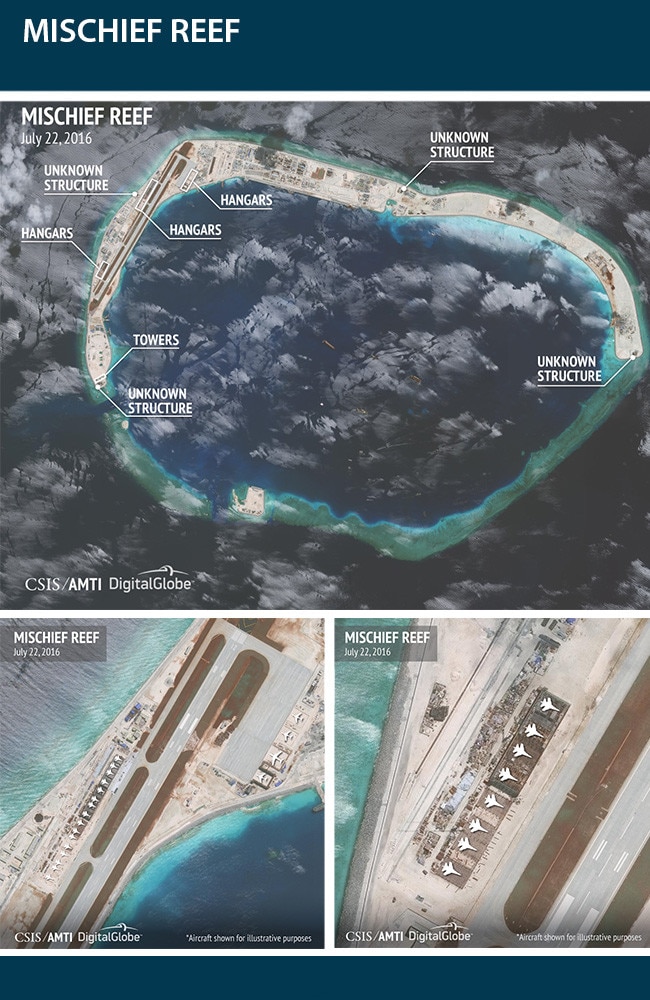Tensions are on the rise over Vietnam's latest alleged move
TENSIONS in the region are again on the rise over what’s been described as one Asian country’s “most significant defensive move”.
TENSIONS in the South China Sea are on the rise following new allegations of missile deployments being set up in disputed areas.
In what has been described as their “most significant defensive move in decades”, Vietnam has reportedly planted new military equipment in the South China Sea.
This sends a strong message to China, with relations between the countries involved in the dispute already getting increasingly tense.
VIETNAM HAS ‘FORTIFIED SEVERAL ISLANDS’
According to Reuters, Vietnam is deploying a mobile rocket launcher system across several of its island holdings in the disputed area.
Western officials said the Extended Range Artillery Rocket (EXTRA) system will be installed in the five bitterly disputed Spratly Islands, within range of China’s newly-built airstrips.
The Israel-based EXTRA is a transportable system that can either be fixed to a truck or installed in a particular location. A single round would have a range of up to 130km, and could carry a 125kg warhead.
The state-of-the-art missiles would therefore be capable of striking China’s land and military infrastructure across the vital trade route.

The sources claim the system is currently unarmed, but could be made operational within two to three days.
Vietnam’s Foreign Ministry has completely dismissed the reports, saying the information is “inaccurate”.
However, it also acknowledged the Vietnamese military has the right to move military equipment on its own sovereign soil.
“It is within our legitimate right to self-defence to move any of our weapons to any area at any time within our sovereign territory,” Deputy Defence Minister Senior Lieutenant-General Nguyen Chi Vinh told reporters.

The move would likely exacerbate existing tensions with Beijing, which, like Vietnam, claims all the islands as its own.
China responded to the purported development by sending through a statement reasserting its claim to the disputed area.
“China has indisputable sovereignty over the Spratly islands and nearby waters,” China’s Foreign Ministry said in a faxed statement. “China resolutely opposes the relevant country illegally occupying parts of China’s Spratly Islands and reefs and ... carrying out illegal construction and military deployments.”
Meanwhile, at a press conference, US State Department Spokeswoman Elizabeth Trudeau urged all countries involved to avoid making any provocative decisions.
“We continue to call on all South China Sea claimants to avoid actions that build tensions, take practical steps to build confidence and intensify efforts that find peaceful, diplomatic solutions to dispute,” she said.

Tensions have existed between China and Vietnam for decades, dating back to a naval battle in the Spratly Islands in 1988.
More recently, it’s been reported the Vietnamese government agencies and major airports have been targeted in a series of cyberattacks.
Ngo Tuan Anh, vice chairman of Vietnamese security company Bkav Corp, told Bloomberg malicious software was found across the country’s government offices, banks, major businesses and universities.
Anh said that, while more evidence was needed to pinpoint the origin, the attacks were clearly political in nature.
CHINA IS SET TO RAMP THINGS UP
As it stands, China is set to militarise its illegal presence in the disputed area.
Even though the country has promised not to pursue militarisation, satellite photos have recently emerged revealing reinforced hangars designed to house combat jets on several of Beijing’s artificial outposts.
The images, distributed by the Washington-based Center for Strategic and International Studies (CSIS) and the Asia Maritime Transparency Initiative, showed military infrastructure being built on Fiery Cross, Subi and Mischief reefs, which are all part of the disputed territories.

The report stated each island would soon be capable of housing 24 fighter jets along with three or four larger aircraft, such as those with surveillance, bomber or tanker roles, allowing Beijing to stage a force of some 70 combat aircraft in the area.
A spokesperson for the CSIS said even the smallest hangars are larger than you would build for civilian purposes, saying they’re “reinforced to take a strike”.
The region has been on high-alert since last month, with Beijing taking a more aggressive stance after an international tribunal found no legal basis to China’s sweeping historic claims to much of the South China Sea.
IS AUSTRALIA AT RISK?
These tensions raise fresh questions as to whether or not Australia will be further dragged into the conflict.
Experts have told news.com.au that, while China is one of our most vital trading partners, Australia can no longer afford to do nothing.
But Dr Adam Lockyer, a security expert at Macquarie University, assured Australia’s presence in the dispute will likely remain a low-risk, largely symbolic gesture for the foreseeable future.
“It’s doubtful the Chinese would intercept Australian aircraft or warship. They could, but they’d choose an easier target.
“There would be economic repercussions, because they need our resources as much as we want them to buy our resources.”
He cited Vietnam as one of the other countries China would be likely to “make an example out of” if push came to shove, but said Australia wouldn’t fall high on this list due to our mutual strategic interests.
— with wires



